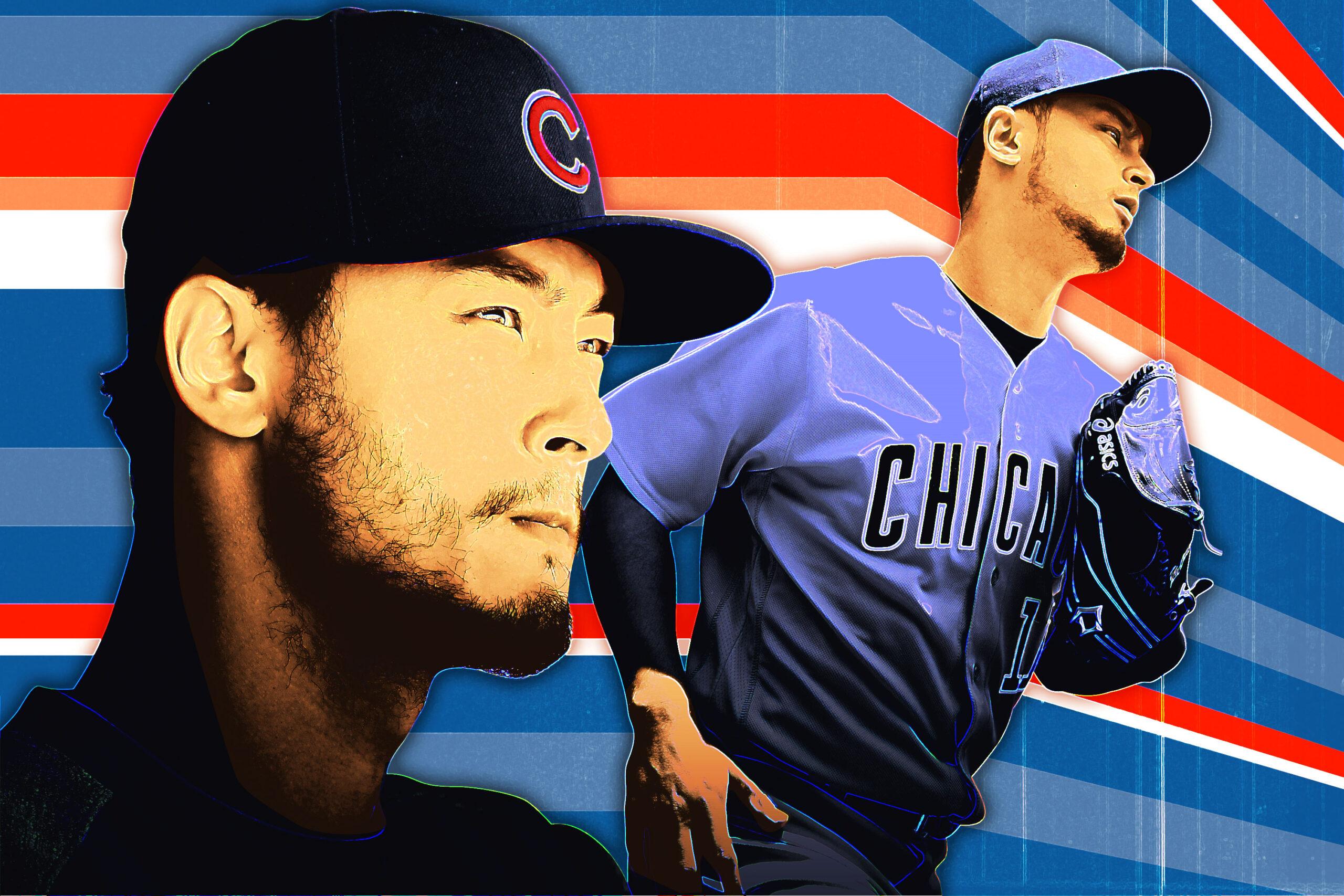
On November 1, 2017, Yu Darvish choked.
In front of an anxious Los Angeles crowd desperate to see their Dodgers end a near-30-year World Series drought, the then-31-year-old pitcher collapsed during the most important start of his career. After facing just three batters, the Astros already had a 2-0 lead. Seven batters and three runs later, Darvish handed Dave Roberts the game ball as he stepped off the mound. The visiting team had scored all it needed to win Game 7 and bring its first title back home to Houston.
“This pain is going to stay in me for a while,” Darvish said through an interpreter to a room full of reporters following the Dodgers’ 5-1 defeat.
In two World Series starts, the Japanese-born right-hander posted an abysmal 21.60 ERA, allowing eight earned runs in 3 1/3 combined innings between his Game 3 and Game 7 losses. Paired with the public humiliation he faced because of Yuli Gurriel’s racist gesture and MLB’s shrug of an immediate disciplinary response, Darvish lived through an embarrassing nightmare on baseball’s greatest stage.
Three months later, Darvish had a new uniform, a six-year contract worth $126 million, and a fresh start in Chicago. He was granted an easy path back to playoff contention, joining a Cubs team just two years removed from their billy-goat-curse-breaking title run. But that brief reprieve of good fortune was soon followed by more pain.
Darvish’s first year as a Cub was an absolute disaster. He got shelled in his debut against the Marlins on March 31, and again during his first start at Wrigley Field on April 13, when he allowed four runs on nine hits in 4 2/3 innings against the Braves. He lacked his typical focus and intensity on the mound, and it didn’t help that the third-most expensive player on the payroll was failing to produce results. “Soft” quickly became a descriptor that followed Darvish, especially after news broke that he was landing on the 10-day disabled list for having the flu. When columnists start characterizing your “reputation as being softer than the Stay Puft Marshmallow Man,” things aren’t going too well. Darvish ended up making only eight appearances in 2018 before undergoing arthroscopic surgery to remove debris from his right elbow. He pitched to a 4.95 ERA and 1.43 WHIP in 40 innings, winning just one game before finishing the season back on the disabled list on May 26.
Entering year two of a contract that’ll nearly outlast the next presidential term, Darvish still technically has plenty of time left in Chicago to prove his deal wasn’t a bad investment. Yet it feels like there’s an urgency that has manifested from a disappointing season for a Cubs team that abruptly fell out of contention, as well as his unforgettable contributions to a seven-game series that most MLB players never get a chance to experience. Whether it’s fair or not, the Cubs need Yu Darvish’s redemption year now.
Darvish has been the subject of blame and disappointment since late October 2017, so it’s easy to forget that he was once one of the most dominant pitchers in the league.
With an impressive résumé that included a Japan Series championship, a Sawamura Award (Nippon Professional Baseball’s Cy Young equivalent), and two Pacific League MVPs, Darvish entered MLB already a polished product with years of professional experience in Japan’s best league. When he left the Nippon-Ham Fighters to sign his first major league contract with the Rangers in 2012, the Japanese ace had a legitimate chance at becoming the second pitcher to ever win both the Cy Young and Rookie of the Year awards in the same season. Darvish fell short of that feat, but he still finished ninth in AL Cy Young voting and third for top rookie honors that year. He followed his strong first season with a league-best 277 strikeouts and a second-place Cy Young finish behind Detroit’s Max Scherzer in 2013.
But after another auspicious start to the 2014 season, which secured him his third consecutive All-Star appearance, Darvish finished the year on the disabled list due to inflammation in his right elbow. He missed all of 2015 after an MRI scan revealed that he’d need Tommy John surgery to repair partially torn ligaments in the same elbow. Darvish began the next season on the disabled list as he recovered from the surgery, and he was later sidelined again as he dealt with shoulder discomfort. Entering his 30s, the sport he’d been playing professionally since the age of 18 had suddenly stopped being fun, as he found himself stuck in a Groundhog Day loop that always ended with him back on the disabled list. With the final year of his contract approaching at the end of the 2017 season, Darvish seriously considered retirement. And then the trade to Los Angeles seemed like it would revitalize.
Dodgers fans would likely be the first to forget, but Darvish was pitching really well leading into the 2017 postseason, before that whole World Series thing happened. In his final three starts of the regular season, he had a 0.47 ERA with a .136 opponents’ batting average in 19 1/3 innings pitched. And even in the playoffs, Darvish earned wins in both the divisional series against the Diamondbacks and the championship series against the Cubs, allowing just two runs in 11 1/3 innings. He had become one of the more reliable members of the Dodgers’ starting rotation, but something changed once he reached the Fall Classic. Whether he began tipping his pitches or the weight of the moment was simply too much, the results remain unchanged. Darvish’s 1 2/3 innings in Game 3 was the shortest start of his major league career, and he matched that mark in Game 7 to become the first pitcher since Art Ditmar in 1960 to go two starts with fewer than two innings pitched in the World Series. It wasn’t exactly a fairy-tale ending for Yu (and it sure as hell wasn’t for the Dodgers, who have yet to end their title drought), but the change in scenery and the sting of those losses provided enough motivation to stave off retirement a little longer.
In 2019, Yu Darvish looks like a whole new person. He reportedly put on 10 to 15 pounds of muscle this offseason, after having dropped 15 pounds this time last year. No longer speaking to the media with the aid of an interpreter, Darvish arrived this spring with a renewed sense of confidence and a desire to prove himself.
“I was so excited,” Darvish said after his Cactus League debut against the D-backs, the first appearance he’d made against major league hitters since May 20, 2018. “It was like this was the first outing in my life.”
Darvish pitched 1 1/3 hitless innings in the 5-4 loss to Arizona, but he allowed two runs (one earned) on four walks as he struggled to find his command. Over his next two starts, he continued to work through command issues, but he started showing flashes of his former self. He threw two more hitless innings against the White Sox, giving up one walk, and after a shaky first two innings against the Rangers, Darvish homed in and allowed only three hits and one earned run over a total four innings of work. He struck out five against his former team but again struggled with his command, as he walked two batters and hit two more. The 32-year-old hasn’t been perfect in this small sample size of spring outings, and he had a minor injury that forced an early exit in his fourth start on Tuesday. (Thankfully it was only a blister, but any injury to Darvish would be enough to make a Cubs fan reach for the panic button at this point.) But he has still produced an impressive 2.25 ERA in four spring starts, and his velocity has consistently sat in the 94-96 mph range—topping out at 97—and most importantly, he’s back on the mound looking both healthy and happy again.
”He’s looked like himself,” Cubs infielder David Bote said after Darvish’s first spring training start. “With the injuries, he was very hard on himself because of it. I think he’s a lot more free in that, and I’m excited to see it. I think we’ll see a good Yu Darvish this year.”
Perhaps even more so now than last year, the Cubs need a good Yu Darvish to show up in what will likely be a tight race in the NL Central.
Chicago fell just short of claiming the division title in 2018, losing the tie-breaking 163rd game of the season to Milwaukee before bowing out of the playoffs early with a loss to Colorado in the wild-card round. A franchise that once looked like a dynasty in the making has now missed the World Series two years in a row, most recently not even reaching the divisional round of the postseason.
With the Cardinals, Brewers, and Reds all adding star power to their lineups this offseason, it won’t get any easier. Preseason projections have the NL Central as the most competitively balanced division in the league, with only nine games separating the top and bottom. PECOTA—Baseball Prospectus’s projection system—has the Cubs pegged for 79 wins in 2019, dead last in the Central.
The Cubs and the Pirates were the only teams in the division to let the offseason come and go without making significant moves to bolster their rosters. Chicago sat out of this free agency’s Harper-Machado sweepstakes, unwilling to spend money because they simply “don’t have any more,” in the words of Cubs chairman Tom Ricketts. Well, a large part of that reasoning is their $126 million pitcher, along with the $20 million still due to the starter they acquired last season at the deadline, Cole Hamels. Chicago signed Darvish to address its rotation problem and fill in the hole left behind by former Cy Young winner and current Phillie Jake Arrieta, and less than a year later they traded for Hamels to address its Darvish (and Tyler Chatwood) problem.
Left now with virtually the same roster as last season—the most notable addition was veteran utilityman Daniel Descalso—the Cubs are relying on their young core to get back on track after a year of regression, as well as for their veteran players to stay healthy and regain their footing. Javy Báez will need to continue to play at an MVP-caliber level, and Kris Bryant will need to step back up to it after a shoulder injury limited his production and playing time to 102 games last season. 2016 World Series hero Kyle Schwarber has to find his swing again after two disappointing seasons at the plate. The same goes for catcher Willson Contreras, who will also have to improve on his pitch framing after being among the worst in the league in that area two years in a row. Starters Jon Lester, Kyle Hendricks, and José Quintana need to pitch deeper into games to relieve pressure off of the bullpen, and Hamels needs to carry his second-half success into his first full year with the Cubs.
The biggest wild card on the team, and possibly its best solution, remains Yu Darvish. Chicago’s rotation could use his penchant for striking out batters, as it yielded a below-average 20.4 percent strikeout rate in 2018 (17th leaguewide). Darvish happens to be third all time among qualified starters in MLB history with a career 29.5 percent strikeout rate. He may affect only one in every five games, but in a division as stacked as this, the Cubs desperately need a boost to a rotation that has failed to live up to expectations over the past couple of seasons.
As spring training winds down and Opening Day quickly approaches, Darvish is primed for a comeback year, and he’s eager to earn the love and respect of the devout Cubs fan base. “I don’t want ‘boo’ anymore,” he told reporters earlier this month as he continues his campaign to win over the media as well. “I want ‘Yu.’ That’s all I want.”


